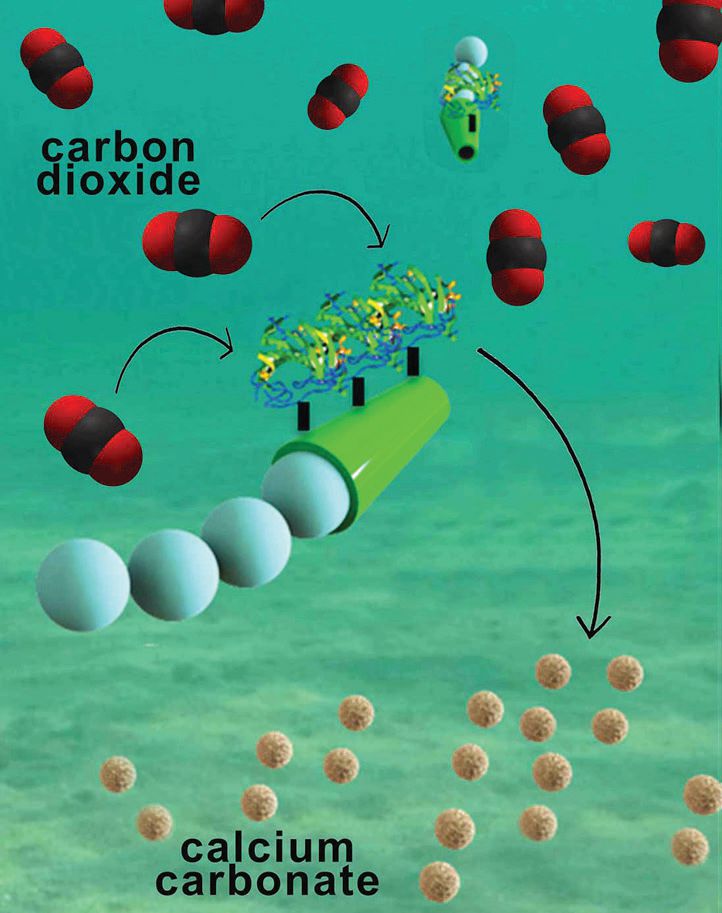More efficient sequestration of carbon dioxide
Dr. Neil Canter, Contributing Editor | TLT Tech Beat December 2015
A new approach enables the enzyme to more efficiently catalyze the conversion of carbon dioxide to calcium carbonate.
KEY CONCEPTS
•
Immobilization of an enzyme on the surface of a micromotor accelerates the removal of carbon dioxide from water.
•
Micromotors traveling at a high rate of speed through water can achieve nearly complete conversion of carbon dioxide to calcium carbonate in minutes.
•
The motion of the micromotors facilitates mixing enabling the enzyme to more rapidly convert carbon dioxide to calcium carbonate.
AS BETTER TECHNOLOGY IS PRODUCED FOR USE ON THE NANOSCALE, more effective micromechanical systems are being developed that can be used in such applications as sensors and piezo generators. The lubrication requirements for these machines differ from those at the macro scale.
A case in point is the preparation of molecular gear machines as described in a previous TLT article (
1). Nanoparticles derived from a core of 44 silver atoms surrounded by 30 para-mercaptobenzoic acid molecules self-assemble into a macroscopic superlattice. Under increasing compression, the individual nanoparticles in the superlattice rotate in a machine-like cooperative motion resembling gears. From a lubricant standpoint, organic ligands in the nanoparticles impart lubricity enabling the gear rotation to take place in a self-lubricating environment where no wear occurs.
The increase in carbon dioxide emissions into the environment is considered to be making a contribution to climate change. This has led to evaluation of different techniques for capturing and sequestering carbon dioxide. Unfortunately none of them exhibit the required performance.
Kevin Kaufmann, graduate student at the University of California, San Diego in La Jolla, Calif., says, “Converting carbon dioxide to calcium carbonate is a relatively straightforward process that can be done quickly with ease of process completion and produce a substance that is valuable in commercial applications.”
The formation of calcium carbonate takes five steps starting with converting carbon dioxide from the gaseous state to being solubilized in water. A critical reaction in this sequence is the hydration of carbon dioxide, which is the rate-limiting step. Kaufmann says, “A very effective way to hydrate carbon dioxide is to use the enzyme carbonic anhydrase. The enzyme is typically immobilized on a solid support to improve stability. The only problem faced is that the limited diffusion of carbon dioxide to the enzyme can significantly hinder conversion to calcium carbonate.”
A new approach is needed to enable the enzyme to more efficiently catalyze the hydration of carbon dioxide. Such a method has now been developed.
MICROMOTORS
A research team led by Professor Joseph Wang of the University of California, San Diego has developed a more effective way to convert carbon dioxide to calcium carbonate by immobilizing carbonic anhydrase on the surface of a micromotor that moves through an aqueous environment containing carbon dioxide. In effect, the micromotor takes the enzyme to the carbon dioxide. Kaufmann says, “Micromotors are conical hollow motors that function by converting chemical energy into propulsion. In our case, we use hydrogen peroxide as the fuel and control the speed of the micromotor by adjusting the hydrogen peroxide concentration.”
At a hydrogen peroxide concentration between 2%-4%, a micromotor can travel at speeds in excess of 100 micrometers per second. Micromotors operating at that speed can achieve calcium carbonate conversions above 85% in deionized water and sea water after operating for no more than five minutes in both media.
The micromotors are prepared from two polymers based on polypyrrole and poly (3, 4-ethylenedioxythiophene). An inner platinum surface was used to catalyze the breakdown of hydrogen peroxide.
Sodium cholate, a known anionic surfactant, also is included in the solution for micromotor operation. Kaufmann says, “The purpose of the surfactant is to control the size of the oxygen bubbles produced as hydrogen peroxide is used as the fuel. The surfactant reduces the surface tension in the solution, enabling the size of the bubble produced to decrease, which leads to an increase in speed.”
As shown in Figure 3, the micromotors move through water reacting with carbon dioxide and releasing calcium carbonate. The blue spheres exiting from the rear of the micromotor are oxygen bubbles. Kaufmann says, “After the micromotors are introduced into the water for five minutes, a soluble calcium ion source is then added leading quickly to the completion of the reaction with the precipitation of calcium carbonate.”
 Figure 3. Functionalization of the surface of a micromotor with a specific enzyme enables the rapid conversion of carbon dioxide to calcium carbonate in water. (Figure courtesy of the Laboratory for Nanobioelectronics, University of California, San Diego Jacobs School of Engineering.)
Figure 3. Functionalization of the surface of a micromotor with a specific enzyme enables the rapid conversion of carbon dioxide to calcium carbonate in water. (Figure courtesy of the Laboratory for Nanobioelectronics, University of California, San Diego Jacobs School of Engineering.)
The motion of the micromotors is a major factor enhancing the reaction of carbon dioxide. Kaufmann says, “The movement of the micromotors acts to facilitate mixing of water leading to the more rapid movement of carbon dioxide molecules to the enzyme surface and as a consequence faster conversion to calcium carbonate.”
Four parameters used by the researchers to evaluate the reaction are the number of micromotors, the concentration of hydrogen peroxide, pH and the time taken by the micromotors to navigate through the solution. In all cases except for pH, carbon dioxide removal increased as each of the other three parameters increased. Optimum carbon dioxide removal was found at a pH of 6 and slowly declined as the pH was further increased to 10. Kaufmann says, “The reason for the different result is that enzyme performance is directly related to the pH of the system.”
The micromotors are very durable—according to Kaufmann—with the longest enzyme activity study being done for 30 days without any difficulty. He says, “The motors themselves never break down and do not need to be treated with any kind of lubricant to maintain performance.”
Micromotors also have been evaluated in other solvents as a way to collect oil. Kaufmann says, “We envision that one potential application for this technology is their use in a decarboxylation plant to take carbon dioxide out of a water stream.”
Future work will involve trying to find another fuel to propel micromotors besides hydrogen peroxide, which can be toxic. Kaufmann says, “We are currently looking to determine if sea water can be used as a fuel and are currently running trials with a magnesium-based catalyst to facilitate the process.”
Additional information can be found in a recent article (
2) or by contacting Wang at
josephwang@ucsd.edu.
REFERENCES
1.
Canter, N. (2014), “Molecular gear machines,” TLT,
70 (7), pp. 8-9.
2.
Uygun, M., Singh, V., Kaufmann, K., Uygun, D., Oliveira, S. and Wang, J. (2015), “Micromotor-based biomimetic carbon dioxide sequestration: Towards mobile microscrubbers,”
Angewandte Chemie International Edition,
54 (44), pp. 12900-12904.
 Neil Canter heads his own consulting company, Chemical Solutions, in Willow Grove, Pa. Ideas for Tech Beat items can be sent to him at neilcanter@comcast.net
Neil Canter heads his own consulting company, Chemical Solutions, in Willow Grove, Pa. Ideas for Tech Beat items can be sent to him at neilcanter@comcast.net.